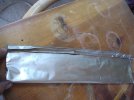Gday folks,
So how effective is stainless steel foil wrap in protecting parts during heat treating when using an atmospheric furnace? That is, from carbuisation and decarubusation.
How do the blades come out - can you close finish them then using stainless foil?
I have been using high pressure gas furnances with inert atmospheres but because it involves another party it costs money that I could otherwise save on.
Thanks
So how effective is stainless steel foil wrap in protecting parts during heat treating when using an atmospheric furnace? That is, from carbuisation and decarubusation.
How do the blades come out - can you close finish them then using stainless foil?
I have been using high pressure gas furnances with inert atmospheres but because it involves another party it costs money that I could otherwise save on.
Thanks






